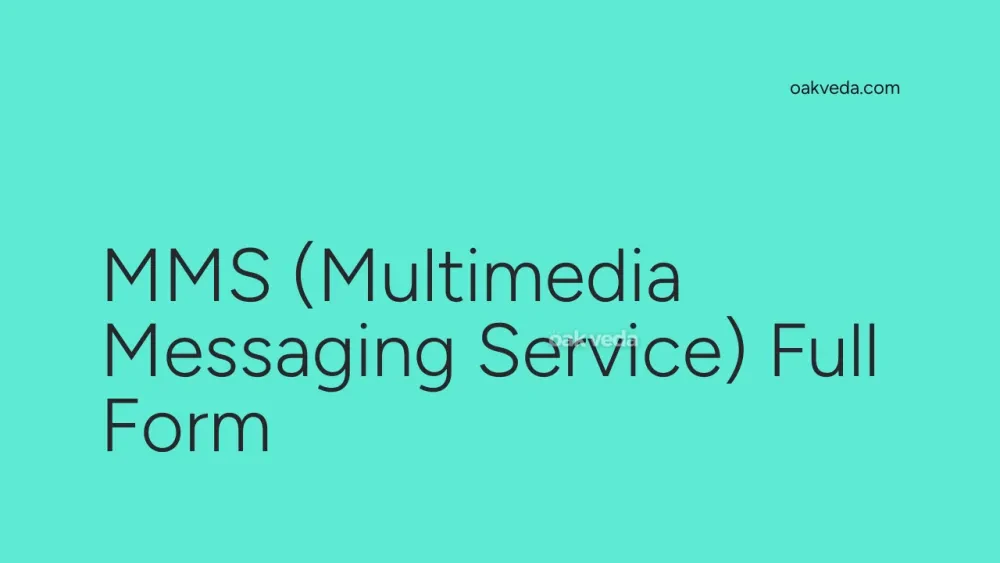
What is the Full Form of MMS?
MMS is the full form of Multimedia Messaging Service. This advanced messaging protocol has revolutionized the way we communicate through mobile devices, allowing users to send and receive rich media content alongside text messages.
What is Multimedia Messaging Service?
Multimedia Messaging Service (MMS) is an enhanced version of the Short Message Service (SMS) protocol. It enables users to send and receive messages that include various types of multimedia content, such as images, audio files, video clips, and formatted text. MMS has significantly expanded the capabilities of mobile communication, offering a more engaging and expressive way to share information.
Origin and Development of MMS
The development of MMS began in the early 2000s as a response to the growing demand for more versatile mobile communication options. Here's a brief timeline of its evolution:
- 2002: MMS was first introduced as a confined technology
- 2003-2005: Initial adoption in various countries, with China emerging as a leading market
- 2010-2013: Rapid growth in MMS traffic in the United States
As mobile networks improved and smartphones became more prevalent, MMS gained widespread popularity, offering users a richer messaging experience compared to traditional SMS.
How does MMS work?
MMS operates on cellular networks, utilizing data connections to transmit multimedia content. The process involves several steps:
- Composition: The user creates a message with multimedia elements
- Encoding: The message is encoded into a standardized format
- Transmission: The encoded message is sent through the cellular network
- Storage: If the recipient's device is unavailable, the message is stored on an MMS server
- Retrieval: The recipient's device downloads the message when ready
- Decoding: The recipient's device decodes the message and displays the content
MMS can work on various network technologies, including GPRS and 3G. While GPRS-based MMS tends to be slower, 3G networks offer faster transmission and support for more complex content like streaming video.
Types of MMS
MMS supports various types of multimedia content, including:
- Images: JPEG, GIF, PNG
- Audio: MP3, WAV, MIDI
- Video: MP4, 3GP
- Text: Plain text, formatted text (HTML)
Functions of MMS
The primary functions of MMS include:
- Sending and receiving multimedia messages
- Supporting group messaging with multimedia content
- Enabling cross-platform communication (between different devices and operating systems)
- Facilitating rich media sharing in personal and business communications
Applications of MMS
MMS has found applications in various fields:
- Personal communication: Sharing photos, videos, and audio messages with friends and family
- Business communication: Sending product images, voice memos, and promotional videos to clients
- Marketing: Delivering rich media advertisements directly to consumers
- News and information services: Distributing multimedia news updates and alerts
- Emergency services: Sending visual information during emergencies or disasters
Features of MMS
Key features of MMS include:
- Multimedia support: Ability to send various types of media in a single message
- Longer message length: MMS can contain significantly more content than SMS
- Formatting options: Users can format text and layout multimedia elements
- Cross-platform compatibility: MMS works across different devices and operating systems
- Group messaging: Ability to send multimedia messages to multiple recipients simultaneously
Benefits of MMS
MMS offers several advantages over traditional SMS:
- Enhanced communication: Allows for more expressive and detailed messages
- Visual impact: Images and videos can convey information more effectively than text alone
- Versatility: Supports various content types for different communication needs
- Improved engagement: Multimedia content tends to capture recipients' attention more effectively
- Business applications: Enables richer marketing and customer communication strategies
Limitations or Challenges of MMS
Despite its benefits, MMS faces some challenges:
- Compatibility issues: Different devices may handle MMS content differently
- Network dependence: Requires a data connection, which may not always be available
- Cost: Sending MMS messages can be more expensive than SMS for some users
- Size limitations: While larger than SMS, MMS still has file size restrictions
- Configuration complexities: Some users may struggle with proper MMS setup on their devices
Future Developments in MMS Technology
As mobile technology continues to evolve, MMS is likely to see further advancements:
- Integration with RCS: Rich Communication Services (RCS) may eventually replace or enhance MMS
- Improved compression: Better compression techniques could allow for larger file transfers
- Enhanced security: Increased focus on encryption and privacy for multimedia messages
- AI-powered features: Integration of artificial intelligence for smart content suggestions and filters
FAQs on MMS Full Form
-
What's the difference between SMS and MMS? SMS (Short Message Service) is limited to text-only messages, while MMS (Multimedia Messaging Service) supports various types of multimedia content.
-
Is MMS available on all mobile phones? Most modern smartphones support MMS, but some older or basic phones may not have this capability.
-
Does MMS use data or text messaging? MMS uses data to transmit messages, which may incur additional charges depending on your mobile plan.
-
Can I send an MMS to someone who doesn't have an MMS-capable phone? In most cases, the recipient will receive a link to view the content online if their device doesn't support MMS.
-
Are there size limitations for MMS messages? Yes, MMS typically has size limitations, which can vary depending on the mobile carrier and device. Common limits range from 300 KB to 3 MB per message.
In conclusion, MMS has significantly enhanced mobile communication by enabling the exchange of rich multimedia content. As technology continues to evolve, MMS remains an important part of our digital communication landscape, bridging the gap between simple text messages and more advanced messaging platforms.
You may be interested in:
- ED (Enforcement Directorate): Full Form and Functions
- UPI (Unified Payments Interface): Full Form and Guide
- LASER (Light Amplification by Stimulated Emission of Radiation)
- FMCG (Fast Moving Consumer Goods): Full Form Explained
- IFFCO (Indian Farmers Fertiliser Cooperative Limited)
- MHD (Magneto Hydrodynamics): Full Form Explained

